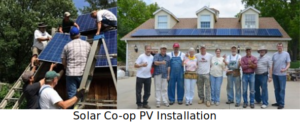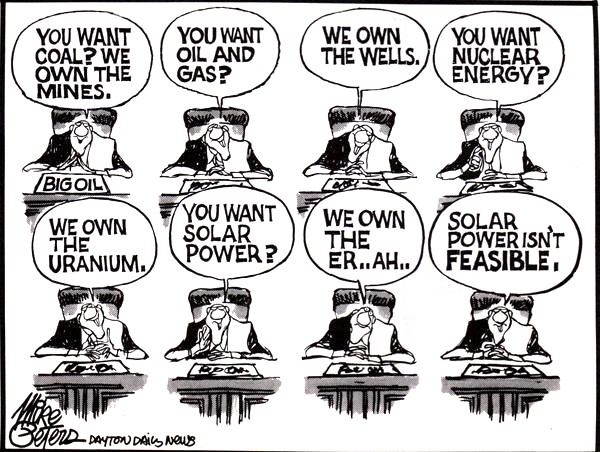On Thursday, 28 June 2018, at 6:00pm, the Kansas Corporation Commission (KCC) scheduled a hearing in Wichita on a combined rate increase request by Westar Energy. The hearing location is Lowe Auditorium, Wichita State University, 5015 East 29th St. N, Wichita KS 67220. The case includes a penalty rate to be charged only on customers with rooftop solar installed after 28 October 2015. Anyone interested in widespread grassroots solar (distributed generation or DG) as opposed to centrally controlled Big Utility solar, is advised to attend. Here is the KCC docket number and link – docket 18-WSEE-328-RTS, but we apologize that the KCC’s web pages are chronically broken, denying the public timely information. However, the KCC Public Comment page does work, so you may submit your comments here – Public Comment_Westar Rate Hike_18-WSEE-328-RTS.

One of their members of the Flint Hills Renewable Energy and Efficiency Co-op (FHREEC) has written a white paper about the implications of the rate case, entitled “Westar’s Rate Request: Why it is Bad for Ratepayers, Kansans, and Westar Themselves”. Here are excerpts:
“Modern grid-tied rooftop solar is a cheap, simple, safe, and an efficient way to generate power. With a do-it-yourself installation (like FHREEC does), a home-owner can double their investment in about 7 years. Systems are modular, expandable, and can be installed safely, with a connection to the Westar power grid for back-up supply or excess power sales. Electricity will flow back into the grid whenever the building’s collectors are generating more electricity than is being used by the occupants. This is called ‘distributed generation’ (or DG), and Westar Energy could choose to incorporate it into their plans for meeting consumer demand, as so many utility companies around the world are doing. Instead they are fighting it.
“Westar proposes to impose a different billing system on customers who generate some of their own electricity, called the ‘demand plan’, a relic of old metering technology invented prior to ‘time-of-use’ meters. Westar has not been transparent about the details of this plan. From what we can tell, customers who generate any of their own electricity would be charged a fixed base fee, plus a volumetric fee, plus a demand fee. The demand fee would be calculated based on the highest 15-min draw placed on the system in a given month (not the average, not the median, but the highest). The solar customer could be charged as much as $70-90 extra on their bill that month.

“Evidence indicates that this rate case is a punitive measure intentionally designed to kill the financial benefits of rooftop solar. Westar views any generation not on their side of the meter as a threat. Westar places solar in the category of ‘risks that adversely affect their bottom line’, admitting that significant advancement in technology and decreased hardware costs make solar generation competitive. They also state that viable battery backups for solar systems are coming on the market, and when advancements in batteries catch up to advancements in panels, it will be easy to leave the grid entirely.
“Current Westar policies intentionally keep consumers in the dark, but they could be more transparent regarding rate structure for DG customers. On www.westarenergy.com, there are examples of how customers are billed under standard rate plans, but no adequate explanation of how DG solar residential rates are currently calculated, nor how the proposed new DG residential rates would be calculated. Generating renewable electricity may be protected by federal laws in the Public Utility Regulatory Policies Act (PURPA). We question whether Westar has any legal basis for punitive action aimed at customers who install a few panels to lower purchased consumption.

“Since DG customers buy less electricity, they are accused of not ‘paying their fair share’, of using the grid as a ‘battery’, or in the wording of the docket, as an energy ‘backup’. Almost by definition, the grid is a backup – for keeping warm or cool or well-lit when we can’t put on an extra sweater, cool off in the shade, or read by the light of the sun. We only purchase energy when we must, but Westar’s wording seems to imply that fixed, high energy consumption is something they have a right to expect of the consumer. By the same logic, would they penalize someone who chooses to conserve energy by drying their clothes on a clothesline instead of using a clothes dryer, and force them into a different rate class? Modernizing the grid is a viable solution to incorporating DG, as has been done elsewhere (see: http://www.raponline.org/document/download/id/7956publication “Teaching the Duck to Fly”).
“Technology exists that would help energy-conscious consumers and Westar work together to combat peak demand problems. Peak demand periods are when utility companies struggle to meet demand, and rooftop solar helps the grid, rather than harms it, by producing peak load power. Because peak load power is worth more than base load power, DG customers should be compensated rather than penalized. The proposed rate structure is counterproductive to Westar’s goal of mitigating peak demand issues. In the near future, many consumers will simply opt to be off-grid entirely unless they are provided with economic incentives to remain faithful to it. Stifling advancements in technology never works in the long term. Corporations that cling to antiquated policies and procedures fail. It is time to work together toward solutions that are forward-looking, fair to consumers who care about controlling their energy costs, and promote the long-term financial viability of Westar Energy.” You may submit your comments to the KCC here – Public Comment_Westar Rate Hike_18-WSEE-328-RTS.


Recent Comments